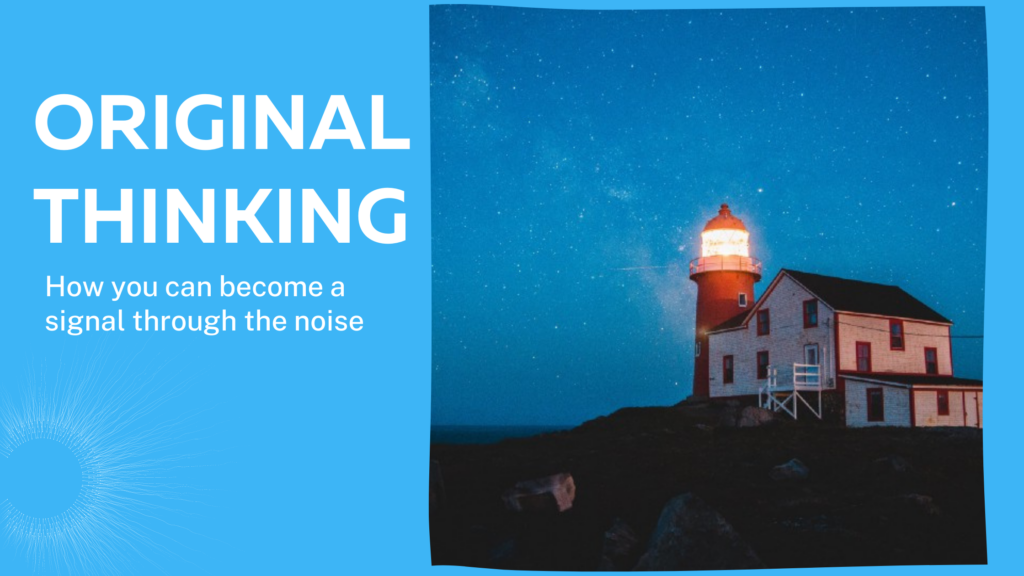How you can become a signal through the noise.
I think of my early days of providing content. Perhaps you can think of yours too. We are focused on getting the message out, showing up every day, and providing a high quantity of content. Rarely do we practice original thinking.
As we develop an audience, all parties mature. We find ourselves in a difficult position and some of our ideas seem shallow and repetitive.
It’s noise. Everyone is talking about the same thing and no one is asking real questions. Noise is the repetition of surface-level ideas. To become a leader in our spaces, we have to become a signal through the noise. Like a lighthouse directing a ship through the fog, our content should be able to dig deeper and resonate with our audience.
The deeper we dig, the more original ideas we can come up with. Yes, there’s nothing new under the sun — except one thing — you. You are unique and your perspective belongs to no one else. Your original ideas can offer real value to real people.
How do we become a signal? We become original thinkers. Frameworks are amazing because they help optimize our process. Here’s one that you can adopt today to become an original thinker.
Be Curious
Be willing to go where no one else goes. The problem with noise is that when we consume it, we’re consuming someone else’s hard work long ago. We never dived into the source and dug deep to find our information and developed conclusions from it.
Original thinking starts with refining our craft for curiosity. We must see it as a skill and take it seriously. That means diving into places few will go. Like exploring an undiscovered cave with real risks and possible rewards, we too need to explore the things that catch our attention on a deeper level.
We might risk the loss of time but by refining the craft we can optimize our process for rewards.
To develop our skill for curiosity, we need to read the source materials that few will venture into.
That means reading books no one ever heard of. Searching Wikipedia pages buried into the database. Contacting experts and communities that are hard to find. This is your gold and helps shape an original idea for your audience.
An easy way to get started is by reviewing the references on a Wikipedia page. For example, if you search for the page covering SEO, at the bottom you’ll see almost 70 possible subtopics within the cited references. These are sources few will take the time to study. There is a high chance an idea exists at an infant stage, waiting for someone to nurture it.

Identify an Interest You’re Passionate About & Study It
Once you’ve followed the rabbit hole and dived deep into something you are curious about, you’ll find something that piques your interest. You’ll know it’s ripe for more when you’ve asked yourself why no one else is talking about it.
Make sure you feel excited about the idea because you are going to be an expert student on it. You’ll have to read more about it and dive into in-depth and obscure works to find information. If you don’t feel this passion, then you’re better off abandoning it and continuing your search for something else.
How do you know which idea is the right one? I like to ask myself the following questions:
1. Do I want to learn it for free?
You can never truly validate an idea until you invest in it. You want to manage your expectations and make sure you have a real passion. Even if it’s successful and resonates with your audience, you’re going to be known for your signal. If you don’t like it, that’s a long road ahead for you.
Ask yourself if you would learn and explore the idea as a hobby because you love the knowledge. If you do, nobody can compete with you and your audience will catch that same passion from you.
2. Is this concept fully articulated or are there gaps?
If the idea is already fully developed, and you still want to explore it, your job might be bringing awareness to it. And that’s fine. But if you want to develop your unique perspective and fully develop a new concept, identify gaps. If you find something missing in the idea’s logic, then you have a real opportunity to build something of your own.
Make sure you can identify which situation you are dealing with and if you are willing to embrace the strategy.
3. Is this well-known to my audience?
Ask yourself if your audience already knows everything about the topic. If they do, then you’re likely not digging deep enough. Or perhaps it has already been fully discovered (which can be rare because there’s always a different angle to approach it — if you feel this way, it’s likely an issue of saturation).
This question forces you to evaluate your audience and whether or not they would be interested in the idea to begin with. Is it relevant to them?
4. Can I give a unique perspective?
Your signal depends on this question. Do you have something new or original to say? Your perspective based on your experiences can add value to an audience. Find a way to communicate it from the heart.
5. Will this benefit others?
Ultimately, a good signal should make a difference. If it isn’t communicated to make people’s lives better then re-evaluate if it’s a signal worth sending.
Deconstruct the Idea
Once you’ve identified an existing idea that has potential… tear. it. down.
Push down the walls of existing thought and expectations. Get it down to its foundation and find out what the true heart of the idea is.
The best way to do this is by incorporating the WHY. What is the true purpose beyond its surface-level value?
When you buy a car, what are you buying?
If you think about it, you’re not spending thousands of dollars to buy a machine. You probably need it to work or to get around town. Why does that matter? You are buying freedom. You are buying an experience. When you sit on leather seats, you feel good traveling wherever you want to go.
The only way we can identify the greater purposes of ideas or what we do is by deconstructing it to the foundation and identifying the core of why it’s important. If a car didn’t go anywhere, we probably wouldn’t want it. Deconstruct your idea and figure out what’s important.
Reconstruct the Idea for Your Audience

Once you know the greater purpose behind an idea, now it’s time to rebuild it to make it relevant for your audience. This is when you become a signal. Add your unique perspective and communicate it.
For our car example, we know it’s about freedom. We dive into what it means to explore and discover new things. You could create an entire series of content on how it can benefit every area in your life. The importance of external discovery to understand your true self.
Ask yourself thought-provoking questions. I think of Socrates and how he would question every understanding people would have on what seemed to be well-developed ideas. As you reconstruct your idea, tackle your doubts. Find out the flaws of the concept and what some of your worst critics might say.
When you’ve identified these things, dive into them. Explore them as you did when you originally found your idea. These spider webs can often lead to productive and valuable content for your signal. It’s often the most valuable.
Reconstructing your idea for an audience is about articulating a strong signal. You know you’ve been successful when others have a conversation about it. Some support it and some challenge it. Then some begin to repeat it, eventually turning it into noise. That’s when you know you’ve done your job as a creator and influence the people around you.
Iterate Your Signal
After you’ve established a signal you begin to build authority. People see you as a leader in that subject. It doesn’t have to end there. After all the time invested into your idea, you can now grow it and discover new avenues and signals connected to it.
Repeat, refine, and dig deeper. Signals are constant. They don’t blink and disappear into the fog. They offer a way out of the fog and into something fulfilling and rewarding for everyone.
Keep going further. Find other ways to communicate your idea. Discover similar paths and build upon them.
The art of original thinking starts with you. By following these steps, you can create content and discover ideas that make a real difference in your community.


